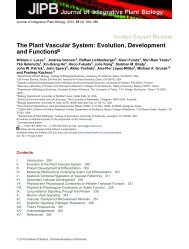Roles of SNARE Proteins in Synaptic Vesicle Fusion - Department of ...
Roles of SNARE Proteins in Synaptic Vesicle Fusion - Department of ...
Roles of SNARE Proteins in Synaptic Vesicle Fusion - Department of ...
You also want an ePaper? Increase the reach of your titles
YUMPU automatically turns print PDFs into web optimized ePapers that Google loves.
48 M.T. Palfreyman, E.M. Jorgensen<br />
Morphologic dock<strong>in</strong>g <strong>of</strong> synaptic vesicles long appeared to be <strong>in</strong>dependent <strong>of</strong><br />
<strong>SNARE</strong>s. Genetic or pharmacologic disruption <strong>of</strong> <strong>SNARE</strong>s did not perturb synaptic<br />
vesicle dock<strong>in</strong>g (12,13,15,154). However, more recent experiments <strong>in</strong>dicate that<br />
dock<strong>in</strong>g <strong>of</strong> synaptic vesicles (14) and dense core vesicles requires syntax<strong>in</strong> (155–<br />
157). Importantly, if syntax<strong>in</strong> is required for dock<strong>in</strong>g, experiments claim<strong>in</strong>g roles for<br />
syntax<strong>in</strong> <strong>in</strong> fusion must be <strong>in</strong>terpreted with caution s<strong>in</strong>ce fusion is downstream <strong>of</strong><br />
dock<strong>in</strong>g. Dock<strong>in</strong>g defects will lead by necessity to defects <strong>in</strong> fusion. The discrepancy<br />
for syntax<strong>in</strong>’s role <strong>in</strong> dock<strong>in</strong>g could be due to different morphologic def<strong>in</strong>itions <strong>of</strong><br />
dock<strong>in</strong>g, which has been def<strong>in</strong>ed as everyth<strong>in</strong>g from direct contact with the plasma<br />
membrane to vesicles 50 nm from the plasma membrane. Alternatively, additional<br />
dock<strong>in</strong>g factors might be present <strong>in</strong> some cell types to ensure the specificity <strong>of</strong> fusion<br />
(155). For example, syntax<strong>in</strong> is required for dock<strong>in</strong>g <strong>in</strong> neurosecretory cells but not<br />
neurons <strong>in</strong> mice (155,157). Perhaps tether<strong>in</strong>g factors also contribute to dock<strong>in</strong>g <strong>of</strong><br />
synaptic vesicles at the active zone (158–162). Overlapp<strong>in</strong>g roles for <strong>SNARE</strong>s and<br />
dock<strong>in</strong>g factors have been observed <strong>in</strong> yeast (163,164). Specifically, sec35 encodes a<br />
tether<strong>in</strong>g prote<strong>in</strong> for Golgi traffick<strong>in</strong>g <strong>in</strong> yeast; sec35 mutants can be partially<br />
bypassed by overexpression <strong>of</strong> the relevant <strong>SNARE</strong> prote<strong>in</strong>s (165). Similarly, overexpression<br />
<strong>of</strong> <strong>SNARE</strong>s can bypass mutations <strong>in</strong> the tether<strong>in</strong>g complex for plasma<br />
membrane fusion (166,167). It is likely that these overlapp<strong>in</strong>g redundant functions<br />
are necessary to achieve the high level <strong>of</strong> fidelity seen <strong>in</strong> membrane traffick<strong>in</strong>g.<br />
Thus far <strong>in</strong> vivo perturbations <strong>of</strong> the <strong>SNARE</strong>s have mostly been shown to selectively<br />
elim<strong>in</strong>ate s<strong>in</strong>gle traffick<strong>in</strong>g steps. However, <strong>in</strong> all cases fusion was not<br />
completely elim<strong>in</strong>ated. There are two possible explanations. First, it is possible that<br />
the <strong>SNARE</strong>s are not execut<strong>in</strong>g fusion—an unlikely <strong>in</strong>terpretation given the wealth<br />
<strong>of</strong> data described above. Second, the <strong>SNARE</strong>s might be partially redundant.<br />
Evidence so far po<strong>in</strong>ts to the latter <strong>in</strong>terpretation. Knockout mice <strong>in</strong> synaptobrev<strong>in</strong><br />
II were found to reta<strong>in</strong> some synaptic activity <strong>in</strong> hippocampal neurons (16). In<br />
chromaff<strong>in</strong> cells, this remnant activity could be attributed to the synaptobrev<strong>in</strong> paralog<br />
cellubrev<strong>in</strong> (168). Redundancy can also expla<strong>in</strong> the rema<strong>in</strong><strong>in</strong>g fusion events <strong>in</strong><br />
synaptobrev<strong>in</strong> null Drosophila mutants. Syb, the Drosophila equivalent <strong>of</strong> cellubrev<strong>in</strong>,<br />
can functionally substitute for n-Syb, the Drosophila equivalent <strong>of</strong> synaptobrev<strong>in</strong>,<br />
when overexpressed <strong>in</strong> neurons (169). Redundancy is also seen <strong>in</strong> the Q<br />
<strong>SNARE</strong>s. SNAP-23, SNAP-47, and SNAP-24 can provide partial function when<br />
SNAP-25 is absent (19,170,171). F<strong>in</strong>ally, redundancy might also expla<strong>in</strong> the almost<br />
complete lack <strong>of</strong> phenotype <strong>in</strong> syntax<strong>in</strong> 1a knockout mice (172), where it is likely<br />
that syntax<strong>in</strong> 1b is sufficient to almost entirely replace syntax<strong>in</strong> 1a action. These<br />
observations are supported by experiments <strong>in</strong> yeast where redundancy between<br />
<strong>SNARE</strong>s has also been conclusively demonstrated <strong>in</strong> numerous traffick<strong>in</strong>g reactions<br />
(173–175). By contrast, loss <strong>of</strong> syntax<strong>in</strong> (unc-64) <strong>in</strong> C. elegans neurons<br />
results <strong>in</strong> a 500-fold reduction <strong>in</strong> neurotransmitter release with no apparent developmental<br />
defects (14); UNC-64 is committed to synaptic vesicle fusion and is<br />
unlikely to have a redundant syntax<strong>in</strong>, like <strong>in</strong> mice; nor is it <strong>in</strong>volved <strong>in</strong> other cellular<br />
functions, like <strong>in</strong> flies (176). In summary, the <strong>SNARE</strong>s do encode specificity;<br />
nonetheless, <strong>in</strong> some <strong>in</strong>stances it is likely that other factors can provide overlapp<strong>in</strong>g<br />
functions to ensure that fusion happens with the appropriate target membrane.<br />
Wang_Ch03.<strong>in</strong>dd 48 5/15/2008 5:27:15 PM
















